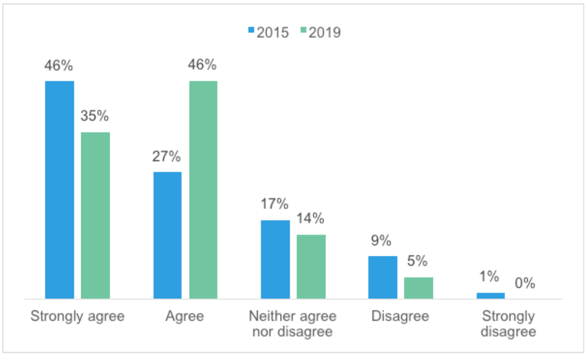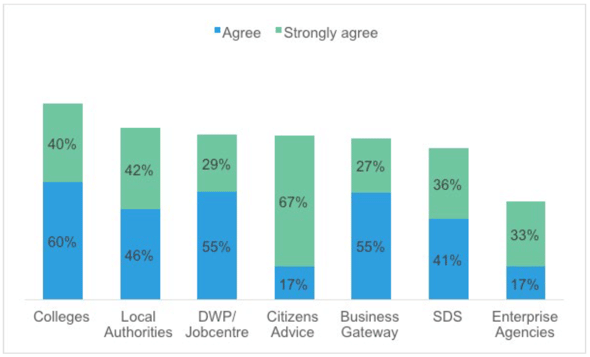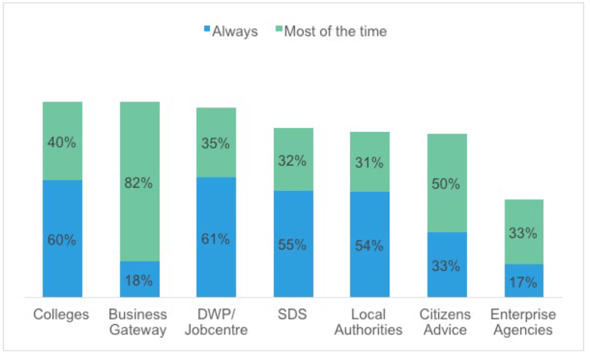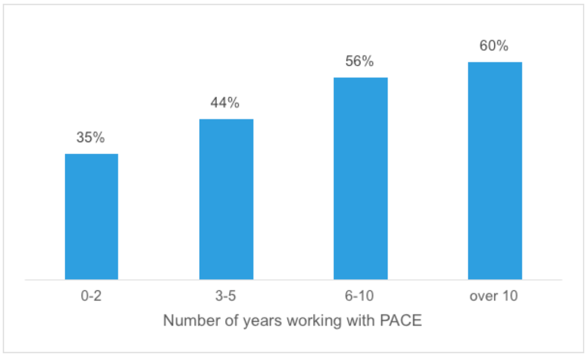PACE partnership review: September 2019
How local PACE partnerships are operating and what current issues they may face.
Processes, Approaches and Reach
This section looks at how effective processes for delivering Partnership Action for Continuing Employment (PACE) services are, how well-resourced local partnerships are, and where improvements could be made to the reach of the service.
Effectiveness of processes and approaches
Approaches to responding to redundancies
There is a well-established and largely standardised approach across local PACE Partnerships which seems to work well.
- National team notifies PACE Chair of a redundancy once the HR1 has been triggered (20 or more redundancies), or they will hear about redundancies through the media, word of mouth, or from other partners.
- PACE Chair generally checks with the Enterprise Agency contact whether the employer is an account-managed business (in these cases the Enterprise Agency representatives may make the initial employer contact).
- PACE Chair takes the lead in mobilising the partnership and deciding what partners need to be involved.
- PACE Chair contacts employer and offers support. Meeting with the employer will usually happen within 48 hours of original notification.
- Presentation offered to all employees (as a minimum), then individual support/signposting offered based on customer need.
- The specific nature of response will be tailored to need, based on size of employer, number of redundancies, profile of staff affected, sector, and imminence of the job losses.
Early identification of customer needs will define the approach and level of support offered. For example, one PACE chair spoke of employees at a particular company who had been identified with pre-existing health conditions. She then tailored the presentation to include information on health services.
Effectiveness of management approaches
We asked respondents to what extent they agreed that their local PACE Partnership was being managed effectively. As Figure 10 shows, the vast majority of respondents either agreed or strongly agreed that management approaches were effective (81%); an improvement on the data available from 2015. The overall proportion disagreeing with this statement has halved since 2015 from 10% to 5%.
Figure 10 Whether you agree that existing local management arrangements for PACE are effective (2015 and 2019)

Source: Local PACE Partner survey 2019 (n=110) and SDS internal data (2015)
The views of local partners from different organisations regarding the effectiveness of management were broadly positive, with College, Local Authority and Department for Work and Pensions (DWP) respondents providing the most positive responses as Figure 11 shows. And although not as high as the other core partner organisations, more than three quarters of Skills Development Scotland (SDS) respondents either agreed or strongly agreed that management was effective. However, only half of Enterprise Agency respondents agreed that the existing local management arrangements for PACE were effective.
Figure 11 Whether you agree that existing local management arrangements for PACE are effective by organisation type

Source: Local PACE Partner survey 2019 (n=110)
Partner and stakeholder responses on the management of the local partnerships were also largely positive:
'It works extremely well - SDS do an excellent job of co-ordinating PACE and communications between all partners is very effective.'
Resourcing
Our Partner Survey asked respondents whether they always had adequate resources to meet the needs of PACE support. In this context, resources will mainly involve staff time to attend PACE meetings. Just under half (48%) stated that they always had adequate resources and a further 40% felt that resources were adequate most of the time. However, around one in eight respondents identified that adequate resources were available only some of the time (12%). As Figure 12 shows, among different types of partner, Colleges and DWP/Jobcentres were most likely to identify adequate resourcing. Skills Development Scotland (SDS) and Local Authority respondents provided a similar response profile; although local authorities had the highest proportion answering 'some of the time' among core partners at 15%. Enterprise Agencies appear to have the biggest issues in resourcing PACE services among the main groups surveyed. Only half identified having adequate resources all the time or most of the time.
Figure 12 Ability to provide the appropriate resources to respond effectively to major redundancies by organisation type

Source: Local PACE Partner survey 2019 (n=112)
The resource requirement will depend on a number of factors. Every case is different, and the response needs to be tailored to meet the specific need. Clearly, the scale of the potential job losses is the main factor, however the lead-in time for providing support will also impact on resources, as one Focus Group participant highlighted:
'The longer lead-in time means that staff can consider career change options; which has implications for resources. With staff looking at career change as a possibility, there is more demand for one-to-one support with SDS and Business Gateway.'
And in another instance, the local SDS PACE team only had a short window for action but required a big response to a specific redundancy which required support from outside of the team. In some smaller, rural areas it can be more difficult to resource larger redundancies, for example in the Outer Hebrides:
'While resources are normally adequate, larger redundancies require staff to be deployed from elsewhere on the islands. There can be nothing for months and then a cluster of two or three redundancy scenarios.'
It also appears that the level of experience with PACE work is a key factor in ensuring that responses are fully resourced. As Figure 13 shows, the longer partners had been engaged with PACE, the more likely they were to be able to always resource PACE responses. Some 60% of those who had more than 10 years' experience highlighted they were always able to effectively resource responses. However, this dropped to just 35% among those with two or less years' experience. This reinforces the issues outlined earlier around the significance of 'mature relationships'. It also presents a challenge for succession planning, where PACE Chairs or organisational leads retire or move on.
Figure 13 Proportion of partners who are always able to provide the appropriate resources to respond effectively to major redundancies by length of time involved with PACE

Source: Local PACE Partner survey 2019 (n=112)
With budgets being stretched among many partners, we also picked up signs of partnership working unravelling slightly, with some pushback against requests for support. Survey respondents highlighted issues with some partners not pulling their weight.
'More commitment from some partners to the concept of partnership working. Some partners are starting to push the boundaries of partnership working to some extent. PACE is the sum total of its parts and some organisations need to understand this better.'
'Partners need to be more aware of what their business has signed up to deliver. There is sometimes a reluctance to respond appropriately by giving the required resource. Very difficult for the PACE Chairs to enforce this so it would be good if this could come from a higher level.'
This highlights the fact that PACE provides coordination of existing services only, rather than adding to service delivery. There is no specific local budget or resource commitment made for PACE at the local level, aside from staff attending meetings.
Improving reach
Employers
Our discussions with local PACE Chairs suggest that most employers are happy to engage with PACE and are keen to make sure their employees get access to the support they need. However, in all areas there seems to be a minority of employers who do not want to engage, or who are actively obstructive to PACE teams. The reasons given include:
- not wanting employees to take time away from work;
- not wanting to antagonise employees; and
- lack of understanding and wariness of what PACE teams will provide.
Some examples given included a smaller, family-run business which was reluctant to engage with the PACE 'banner' because they were wary that the PACE team engaging with staff would 'cause trouble'. In this instance, the Chair did his best to inform the business owner about the PACE role and to ensure those facing redundancies received support.
Another issue, highlighted in one of our rural focus groups, was where construction workers are laid off as contracts come to an end. This generally happens 'under the radar' and, while they are technically being made redundant, this is a cyclical part of the construction industry, and employers will not generally engage with PACE teams. Workers will generally use their down time to upskill or to renew/upgrade their Construction Skills Certification Scheme (CSCS) tickets. However, partners report that it is difficult to secure funding to support them. While the numbers may be quite small, sometimes three or four workers, this can have a significant impact on small, rural communities and economies.
Smaller contractors and SMEs are harder to reach as they are less likely to have day to day contact with partners. They won't necessarily know who to go to. Issues around smaller employers were also highlighted through the survey:
'Small companies with no HR dept often don't know how to proceed in making redundancies, don't know about SDS or PACE.'
'employees from smaller companies can slip through the net as no HR1 requirement which formally kicks in PACE services. Better marketing so those individuals know to approach SDS for holistic overview of PACE services.'
It can be more difficult to reach employers where the company has closed down very quickly and gone into administration. However, the national team has developed very good relationships with the main administrators, which makes it easier to provide services to employees in these circumstances.
Other employers who may not engage with PACE are those who use private sector out-placement agencies. As one survey respondent highlighted:
'Companies with head offices in England or abroad often hire in redundancy help as they are unfamiliar with SDS and PACE. It's difficult then for us to get in.'
However, we came across several instances where PACE teams coordinated activity and worked closely alongside out-placement services (including Michelin and Talk Talk). They reported a good balance between the sectoral specialism of the private sector and the local knowledge of labour market and funding that the PACE team brings.
Employees
Several partners highlighted the difficulties in providing services to night shift workers affected by redundancies. Given that most partner organisations work around standard daytime working hours, delivering support to night shift workers usually requires an SDS adviser and/or a DWP representative to volunteer to attend a night-time session. This will happen from time to time; particularly where the redundancy is a larger manufacturer. One respondent identified the possibility of making better use of technology to either record the presentation or deliver it through a webinar or similar web-based format.
In some scenarios where there are large numbers of migrant workers, communication and language issues can emerge. This was identified in several areas, including the Outer Hebrides, Borders, Fife, Dumfries and Galloway and Inner Moray Firth. PACE teams have generally been able to address these issues through accessing either a partner organisation representative or employee representative who is bilingual. With one fish processing redundancy, there was a need to use an interpreter to translate. PACE information packs are available in various EU languages.
Marketing and publicity
Partners highlighted the importance of ensuring awareness and visibility of the PACE service. Good partnership links and relationships are key to this, with intelligence being shared and passed on through the local partners. In one partnership area, they had ensured there was prominent PACE presence in business materials such as local business and service directories, so that businesses could find the details without partners having to 'push' it to potential customers.
Several local partnership Chairs were aware of the radio advertisement about PACE services, although none of these could identify whether it had made much of an impact.
A few interviewees and stakeholders highlighted the issue of the PACE name and brand; suggesting that it was not always clear to customers what PACE stands for and what services it offers. Another issue identified by some of the interviewees was the difficulties that partners had in marketing the services of PACE, because it may portray too negative a perspective. This was highlighted by Enterprise Agency staff in particular, who wanted their interactions with businesses to focus on more positive aspects of business growth.
One focus group participant suggested that it would be useful to understand how employers or individuals find out about PACE as part of the data recording process.
Contact
Email: margaret.sutor@gov.scot
There is a problem
Thanks for your feedback